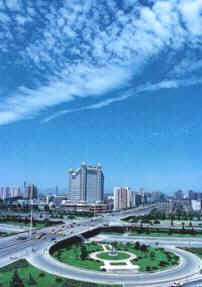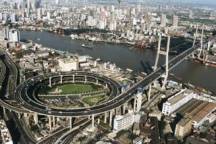|
|
|
Major
Cities
China
now has 668 cities, of which 13 have populations of more than two
million each; 24, between one and two million; 48, between 500,000
and one million; 205, between 200,000 and 500,000; and 378, less
than 200,000.
|
|
Beijing Beijing
is a municipality directly
under the Central Government and the capital of the PRC, with an
urban population of 7.34 million. It is not only the nation??s political
center, but also its cultural, scientific and educational center,
and a key transportation hub. Situated on the north edge of the
North China Plain, it is sheltered by chain upon chain of mountains
to the west, north and east. Its southeastern part is a plain. Beijing??s
temperate continental climate produces four clearly contrasted seasons:
a short spring, rainy and humid summer, long and cold winter, and
a very pleasant autumn.
|

A
flyover in Beijing.
|
|
Beijing
emerged as a city as far back as the Western Zhou Dynasty (11th
century-770 B.C.), then known as
Ji. During the Warring States Period (475-221 B.C.) it was
the capital of the State of Yan. Ji had ever since remained a city
of strategic importance and a trade center for the north for well
over a thousand years. Then, in the early 10th century, it became
the secondary capital of the Liao Dynasty under the name of Yanjing.
Between 1115 and 1911, it served in succession as the capital of
the Kin, Yuan, Ming and Qing dynasties, thus becoming a storehouse
of Chinese culture, and leaving many superb historical legacies,
such as the Tiananmen Gatetower, the symbol of Beijing as
well as of China; Tiananmen Square, the largest city square in the
world; the former Imperial Palace (the ??Forbidden City??), the largest
and best-preserved ancient architectural complex of the world; the
Great Wall at Badaling, one of the ??wonders of the world??; the Temple
of Heaven, the largest of all existing temples in the world, where
the emperors of the Ming and Qing dynasties worshiped Heaven and
prayed for good harvests; the Summer Palace, the largest imperial
garden in the world; the Ming Tombs, the largest imperial tomb group
in the world; and Prince Gong??s Residence. Of these, the former
Imperial Palace, the Great Wall and the site of the discovery of
Peking Man at Zhoukoudian have been listed as world cultural heritages
by the UN Educational, Scientific and Cultural Organization.
The city of Beijing has preserved
the imperial architecture of the Ming Dynasty well. In the city??s
center is the oblong Imperial Palace, which is surrounded by a 10-odd-meter-tall
wall topped with a turret on each of the four corners and skirted
by a moat. Outside of the Imperial Palace is the original Imperial
City??s vermilion walls, nine km in circumference and having many
symmetrical city gates. In addition, there is also a square ??inner
city?? 20 km in circumference, and an oblong ??outer city?? in the
south of the ??inner city.?? Hence the city of Beijing is in the shape
of a Chinese character ?????
With the Forbidden City at the center, there is a central axis running
through it from north to south, on either side of which are streets,
shops and residential houses laid out in a symmetrical chequerboard
pattern. Winding rivers, beautiful gardens, and ancient and solemn
sacrificial altars and temples are scattered all over the city,
adding beauty to its symmetrical pattern.
As
an ancient city, Beijing is also attractive for its new look. Since
1949, when Beijing was designated as the capital of the PRC, tremendous
changes have taken place in the city??s appearance. In the past, Tiananmen
Square was an imperial square forbidden to ordinary people, with vermilion
walls on the eastern and western sides. In the 1950s, the walls were
pulled down, and the square was expanded from 11 ha to 40 ha, where
citizens go sightseeing, hold rallies, have recreational activities
and relax. The square is now flanked by massive modern buildings,
including the Great Hall of the People, where the NPC is held annually,
the Museum of Chinese History, the Museum of the Chinese Revolution,
the Monument to the People??s Heroes and the Chairman Mao Memorial
Hall. North of the square, Chang??an Avenue has been widened and extended.
Today it is the city??s major west-east artery, lined on either side
with towering new buildings. Since the 1980s, the urban construction
of Beijing has developed at a high speed. Now more than 200 star-rated
hotels and several dozen high-class shopping centers are distributed
all over the city. The National Library of China, the Central TV Center,
the World Trade Center, the International Exhibition Center, the China
Theater, the Beijing West Railway Station and other modern buildings
now tower on the Beijing skyline. The construction of the ring roads,
expressways to the airport and the Great Wall at Badaling, about 200
flyovers, the new sports city at the Asian Games Village, and so on,
have added a modern flavor to the old city. If you take a view of
the city from the Wanchun Pavilion at the peak of Jingshan (Prospect
Hill), you will find the ??inner city?? of Beijing has been surrounded
by towering buildings. The ancient architectural complexes and the
new buildings, which add radiance and beauty to each other, seem to
form a huge new painting scroll of Beijing. |
|
Shanghai Shanghai,
a city directly under the Central Government, is China??s largest
city, with an urban population of 9.54 million. Advantageously located,
Shanghai is located halfway down China??s mainland coastline,
where the Yangtze River empties into the sea. An important comprehensive
industrial base and harbor, Shanghai plays an essential role in
the national economy. Major industries include metallurgy, machine-building,
shipbuilding, chemicals, electronics, instruments and meters, textiles
and other light industries, in addition to its highly developed
commerce, banking and ocean-going shipping industry. The Pudong
New Zone, separated from the old city by the Huangpu River, is now
undergoing vigorous development and construction. Its look changes
with each passing day. The opening and development of the Pudong
New Zone is intended to build it into a modern, multi-functional,
export-oriented district, on a par with the world??s best. This will
lay the foundation for the transformation of Shanghai into an international
economic, banking and trade center, and a modern international city.
|

A
distant view of Nanpu Bridge in Shanghai.
??
??
??
|
|
Tianjin
Tianjin, another city directly under the Central Government,
is a major industrial and commercial city in north China, with an
urban population of 5.21 million. About 120 km from Beijing, Tianjin
is an important port for ocean-going and offshore shipping, and
foreign trade. Tianjin??s traditional industries include iron and
steel, machine-building, chemicals, power, textiles, construction
materials, paper-making and foodstuffs, plus some rising industries
such as shipbuilding, automobile manufacturing, petroleum exploitation
and processing, and the production of tractors, chemical fertilizers,
pesticides, watches, TVs and cameras.
|

The
Tianjin Development Zone.
|
|
Chongqing
Chongqing, also a city directly under the Central Government,
is the largest industrial and commercial center in southwest China
and a hub of land and water transportation in the upper Yangtze
valley, with an urban population of 6.14 million. Located at the
juncture of the Yangtze and Jialing rivers, its city proper is surrounded
by these rivers on three sides and stands on a mountain, like a
peninsula. Hence the name ??Mountain City.?? Chongqing is a comprehensive
industrial city, with advanced iron and steel, chemicals, power,
automobile manufacturing, machine-building, shipbuilding, construction
materials, textiles, foodstuffs and pharmaceuticals industries.
As a new centrally administered city established in 1997, Chongqing
is facing new chances for development. For instance, it is becoming
more and more important in China??s strategy for the great development
of western China, and it is playing a more and more important role
in the development and opening of the areas along the Yangtze River.
Besides, huge market demands have been formed during the construction
of the Three-Gorge Water Conservancy Pivot Project on the Yangtze
River and migration from the Three-Gorge Reservoir Area.
|

Night
view of the People's Hall of Chongqing.
??
|
|
Guangzhou
Guangzhou, the capital of Guangdong Province, spans the Pearl
River. It is the largest and most important gateway in south China,
with an urban population of 4.17 million. As the oldest trading
port in China, Guangzhou was a foreign trade hub as early as in
200 B.C. The Huangpu Port, where ocean-going ships can anchor, has
navigation lines reaching all continents in the world. Since 1957,
a bi-annual Chinese export commodities fair has been held here,
one in spring and the other in autumn. As an important entry/exit
port for overseas tourists, Guangzhou boasts a great number of modern
hotels.
|

Shennan
Avenue in Shenzhen.
??
|
|
Xi'an
Xi'an,
capital of Shaanxi Province, is the largest city in northwest China,
with an urban population of 2.72 million. Originally known as Chang??an,
Xi??an is a famous ancient city in China and was the starting point
of the ancient Silk Road. From the 11th century B.C. on, it served
as the capital of a dozen dynasties. Hence Xi??an boasts a large
number of historical sites, such as the site of the pre-historic
Banpo Village, which was a matrilineal commune, the life-size terracotta
horses and armored warriors excavated from sites near the mausoleum
of Emperor Qin Shi Huang, the Greater and Lesser Wild Goose pagodas
of the Tang Dynasty, and the Stele Forest of the Song Dynasty, all
of which are well known both at home and abroad. Xi??an now is both
a tourist city and one of the rising industrial bases in China,
known for its advanced machine-building and textiles industries.
Wuhan
Wuhan, the capital of Hubei Province, consists of the cities
of Wuchang, Hankou and Hanyang, with a total urban population of
4.28 million. As the largest city in central China and the hub of
land and water transportation on the middle reaches of the Yangtze
River, Wuhan has advanced iron and steel, machine-building, ship-building,
textiles, chemicals and foodstuffs industries.
Shenyang
Shenyang, the capital of Liaoning Province, is the largest
city in northeast China, with a total urban population of 4.24 million.
As a heavy-industrial city, Shenyang takes pride in its machinery,
electrical equipment and heavy-duty machines industries. |
|



